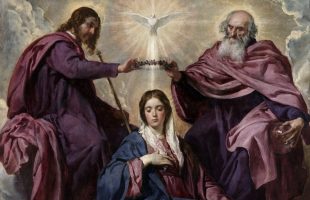
Lesson Objectives
- To understand the biblical foundations of the Dogma of the Assumption.
- To understand the deep Old Testament symbolism and imagery in Revelation 12, and its relation to Catholic beliefs about Mary.
- To appreciate how the biblical portrait of Mary is reflected and interpreted in the Church’s liturgy.
I. Seeing Mary with Catholic Eyes
A. Course Review
In this course, we’ve undertaken a close study of the place of Mary in the Bible.
We’ve seen that although there are few direct references to Mary in the New Testament, she is depicted at each critical juncture in the life and work of Christ - His birth, the beginning of His public ministry, His death and resurrection, and the sending of His Spirit at Pentecost.
We’ve seen also that the New Testament accounts describe Mary in terms of Old Testament scenes and promises - as a new Eve, as Daughter Zion, as the ark of the new covenant, and as Queen Mother of the kingdom of God’s people.
In our last lesson, we discussed how the Church has continued to reflect on the biblical testimony to Mary’s place in salvation history. We considered how this on-going reflection has led to the formulation of doctrines and dogmas concerning Mary’s Immaculate Conception, her status as the "ever-virgin Mother of God," and her "Assumption" into heaven as "Queen of all things."
And, as we noted, these doctrines represent the Church’s definitive interpretations of the Scriptures concerning Mary.
B. Modern Marian Dogmas
We focused in that last lesson on the Immaculate Conception, the first Marian doctrine to be proclaimed in the modern era. In this final lesson we will take a close look at the most recent of the Marian dogmas - the Assumption, pronounced by Pope Pius XII in 1950.
That dogma states that, at the end of her time on earth. Mary was taken up - body and soul - to heaven.
Like the Immaculate Conception, the Assumption is not an event recorded in Scripture. Indeed, the last mention of Mary in the biblical narrative is in relation to the life of the early Church in the days between the Ascension and Pentecost (see Acts 1:14).
But in Munificentissimus Deus ("The Most-Bountiful God"), Pius pointed to a long heritage of belief in the Assumption - an ancient tradition expressed in homilies, prayers, the dedication of churches, and the celebration of liturgies.
Underlying this tradition was a rich vein of Scriptural meditation and interpretation.
At the center of this tradition is the mysterious, apocalyptic vision of Revelation 12. As we noted in Lesson 4, the heavenly queen mother depicted in this vision is both a symbol of Mary and at the same time a symbol of the Church.
In this final lesson, we want to look more closely at this vision.
We will examine how it undergirds the Assumption dogma. And, through a close study of the text, we’ll also see how this vision ties together many of the Old Testament images used to describe Mary and her pivotal place in God’s saving plan.
Other Lessons
- Lesson One: A Biblical Introduction to Mary
- To understand the basic outlines of the New Testament’s witness to Mary.
- To appreciate how the Old Testament forms the essential background for what the New Testament teaches about Mary.
- To understand “typology” and its importance for reading the New Testament texts concerning Mary.
- Lesson Two: Wedding at Cana, Garden in Eden
- To appreciate the Old Testament symbolism that forms the deep background to the Gospel account of the wedding feast at Cana.
- To understand how Mary is depicted as a “New Eve” in this account.
- To appreciate the importance of the Old Testament marriage symbolism for John’s recounting of the “sign” at Cana.
- Lesson Three: The Ark of the New Covenant
- To see how Mary’s visit to Elizabeth parallels David’s bringing of the Ark of the Covenant to Jerusalem.
- To understand how the book of Revelation uses the startling image of the rediscovered Ark of the Covenant to introduce a vision of the Mother of Christ.
- To understand why the New Testament writers see Mary as the Ark of the New Covenant.
- Lesson Four: Mother Crowned in Glory
- To see the importance of the Queen Mother in the Davidic kingdom of the Old Testament.
- To understand the duties and privileges that came with the position of Queen Mother.
- To see how Mary fills the position of Queen Mother in the kingdom of Christ.
- Lesson Five: The All-Holy Mother of God
- To understand the relationship between Catholic teaching about Mary and the Scriptural portrayal of Mary.
- To understand the biblical foundations of the Dogma of the Immaculate Conception.
- To appreciate how Catholic belief in the Immaculate Conception flows from the New Testament portrait of Mary as the “New Eve”